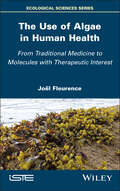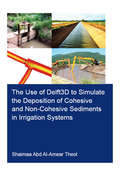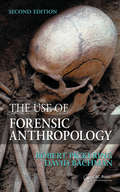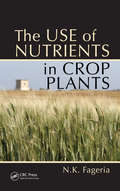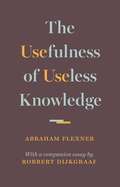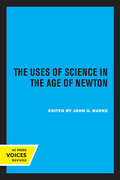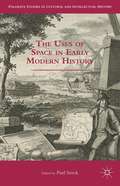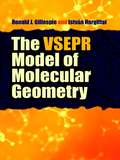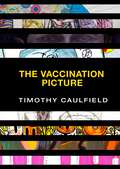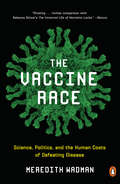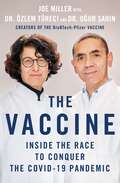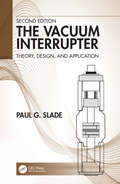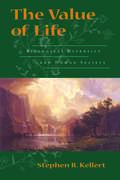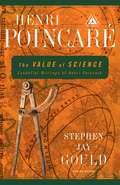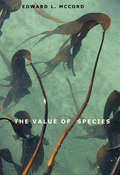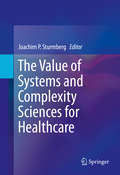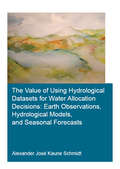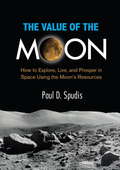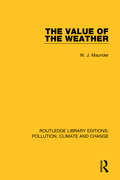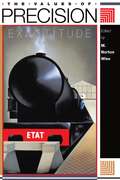- Table View
- List View
The Use of Algae in Human Health: From Traditional Medicine to Molecules with Therapeutic Interest (ISTE Invoiced)
by Joël FleurenceThe Use of Algae in Human Health explores the use of algae in traditional Asian medicine, for both preventive and curative purposes. The book looks at both historical and current uses, as algae is still used on an empirical basis in popular medicine in Asia. The first part of this book focuses on the integration of algae into the therapeutic practice of ethnomedicine. The second part focuses on molecules derived from algae, which include fucoidans, alginates, carrageenans and polyphenols; they have been described in the scientific literature as having therapeutic activities both in vitro and in vivo. These varied functions (antitumoral, antiviral, antibacterial, antithrombotic, anti-inflammatory and antioxidant) are of major interest in human health. However, new drugs based on algal molecules are proving slow to develop. The book reviews the scientific, technological and economic obstacles that may explain why development is lagging.
The Use of Delft3D to Simulate the Deposition of Cohesive and Non-Cohesive Sediments in Irrigation Systems (IHE Delft PhD Thesis Series)
by Shaimaa Abd TheolSediment deposition threatens the performance of many irrigation systems. Because of the high impact on irrigation performance and crop production, many studies have been done on how to deal with sediment deposition. In this research, the Delft3D model, originally developed for hydro-morphologic modeling of rivers and estuaries, was adapted for the use in irrigation systems simulations and applied to different case studies. This research addresses two shortcomings of previous studies of sediments in irrigation systems. Firstly, while previous studies primarily used 1D models, this research uses a 2D/3D model. The use of 2D/3D models in irrigation systems is significant because the non-uniform flow around structures such as offtakes, weirs and gates, leads to asymmetric sedimentation patterns that are missed by 1D simulations. Secondly, whereas previous studies mostly considered non-cohesive sediments, this research simulates cohesive, non-cohesive and a mix of both sediment types. This is important for irrigation systems that draw water from natural rivers that carry a mix of cohesive and non-cohesive sediments. The findings of this research are important for irrigation system maintenance and gate operation. It is also essential for the development of canal operating plans that meet crop water requirements and at the same time minimizes sediment deposition by alternating gates.
The Use of Forensic Anthropology
by Robert B. Pickering David BachmanA forensic investigation requires a team of specialists from many different scientific fields of study along with legal and law enforcement specialists. In recent years, the range of cases on which forensic anthropologists have been consulted has expanded dramatically. The Use of Forensic Anthropology provides these professionals with guidelines fo
The Use of Nutrients in Crop Plants
by Nand Kumar FageriaPut Theory into PracticeScarcity of natural resources, higher costs, higher demand, and concerns about environmental pollution- under these circumstances, improving food supply worldwide with adequate quantity and quality is fundamental. Based on the author's more than forty years of experience, The Use of Nutrients in Crop Plants
The Usefulness of Useless Knowledge
by Abraham Flexner Robbert DijkgraafA forty-year tightening of funding for scientific research has meant that resources are increasingly directed toward applied or practical outcomes, with the intent of creating products of immediate value. In such a scenario, it makes sense to focus on the most identifiable and urgent problems, right? Actually, it doesn't. In his classic essay "The Usefulness of Useless Knowledge," Abraham Flexner, the founding director of the Institute for Advanced Study in Princeton and the man who helped bring Albert Einstein to the United States, describes a great paradox of scientific research. The search for answers to deep questions, motivated solely by curiosity and without concern for applications, often leads not only to the greatest scientific discoveries but also to the most revolutionary technological breakthroughs. In short, no quantum mechanics, no computer chips.This brief book includes Flexner's timeless 1939 essay alongside a new companion essay by Robbert Dijkgraaf, the Institute's current director, in which he shows that Flexner's defense of the value of "the unobstructed pursuit of useless knowledge" may be even more relevant today than it was in the early twentieth century. Dijkgraaf describes how basic research has led to major transformations in the past century and explains why it is an essential precondition of innovation and the first step in social and cultural change. He makes the case that society can achieve deeper understanding and practical progress today and tomorrow only by truly valuing and substantially funding the curiosity-driven "pursuit of useless knowledge" in both the sciences and the humanities.
The Uses of Science in the Age of Newton (Clark Library Professorship, UCLA #8)
by John G. BurkeThis title is part of UC Press's Voices Revived program, which commemorates University of California Press’s mission to seek out and cultivate the brightest minds and give them voice, reach, and impact. Drawing on a backlist dating to 1893, Voices Revived makes high-quality, peer-reviewed scholarship accessible once again using print-on-demand technology. This title was originally published in 1983.
The Uses of Space in Early Modern History
by Paul StockWhile there is an growing body of work on space and place in many disciplines, less attention has been paid to how a spatial approach illuminates the societies and cultures of the past. Here, leading experts explore the uses of space in two respects: how space can be applied to the study of history, and how space was used at specific times.
The VSEPR Model of Molecular Geometry (Dover Books on Chemistry)
by Prof. Ronald J Gillespie Prof. Istvan HargittaiValence Shell Electron Pair Repulsion (VSEPR) theory is a simple technique for predicting the geometry of atomic centers in small molecules and molecular ions. This authoritative reference was written by Istvan Hartiggai and the developer of VSEPR theory, Ronald J. Gillespie. In addition to its value as a text for courses in molecular geometry and chemistry, it constitutes a classic reference for professionals.Starting with coverage of the broader aspects of VSEPR, this volume narrows its focus to a succinct survey of the methods of structural determination. Additional topics include the applications of the VSEPR model and its theoretical basis. Helpful data on molecular geometries, bond lengths, and bond angles appear in tables and other graphics.
The Vaccination Picture
by Timothy CaulfieldFew topics in health policy have generated as much debate—and frustration—among public health experts as the issue of vaccine safety. Misinformation around the science of vaccination continues to spread, and too often the media fails to report bad science for what it is. Using science-informed analysis alongside original art and powerful essays, health science leader Timothy Caulfield debunks the myths and false assumptions about vaccination safety and effectiveness. Accessible, informative, and entertaining, The Vaccination Picture tells the true story of vaccines, their uses, and their positive effects for everyone.
The Vaccine Race: Science, Politics, and the Human Costs of Defeating Disease
by Meredith Wadman“This is a story about the war against disease—a war without end—and the development of enormously important vaccines, but in telling that story, in showing how science works, Meredith Wadman reveals much more. I loved this book.” —John M. Barry, New York Times bestselling author of The Great InfluenzaThe epic and controversial story of a major breakthrough in cell biology that led to the conquest of rubella and other devastating diseases. Until the late 1960s, tens of thousands of American children suffered crippling birth defects if their mothers had been exposed to rubella, popularly known as German measles, while pregnant; there was no vaccine and little understanding of how the disease devastated fetuses. In June 1962, a young biologist in Philadelphia, using tissue extracted from an aborted fetus from Sweden, produced safe, clean cells that allowed the creation of vaccines against rubella and other common childhood diseases. Two years later, in the midst of a devastating German measles epidemic, his colleague developed the vaccine that would one day wipe out homegrown rubella. The rubella vaccine and others made with those fetal cells have protected more than 150 million people in the United States, the vast majority of them preschoolers. The new cells and the method of making them also led to vaccines that have protected billions of people around the world from polio, rabies, chicken pox, measles, hepatitis A, shingles and adenovirus. Meredith Wadman’s masterful account recovers not only the science of this urgent race, but also the political roadblocks that nearly stopped the scientists. She describes the terrible dilemmas of pregnant women exposed to German measles and recounts testing on infants, prisoners, orphans, and the intellectually disabled, which was common in the era. These events take place at the dawn of the battle over using human fetal tissue in research, during the arrival of big commerce in campus labs, and as huge changes take place in the laws and practices governing who “owns” research cells and the profits made from biological inventions. It is also the story of yet one more unrecognized woman whose cells have been used to save countless lives. With another frightening virus imperiling pregnant women on the rise today, no medical story could have more human drama, impact, or urgency today than The Vaccine Race.From the Hardcover edition.
The Vaccine: Inside the Race to Conquer the COVID-19 Pandemic
by Joe Miller Özlem Türeci Ugur SahinWinners of the Paul Ehrlich PrizeThe dramatic story of the married scientists who founded BioNTech and developed the first vaccine against COVID-19.Nobody thought it was possible. In mid-January 2020, Ugur Sahin told Özlem Türeci, his wife and decades-long research partner, that a vaccine against what would soon be known as COVID-19 could be developed and safely injected into the arms of millions before the end of the year. His confidence was built upon almost thirty years of research. While working to revolutionize the way that cancerous tumors are treated, the couple had explored a volatile and overlooked molecule called messenger RNA; they believed it could be harnessed to redirect the immune system's forces against any number of diseases. As the founders of BioNTech, they faced widespread skepticism from the scientific community at first; but by the time Sars-Cov-2 was discovered in Wuhan, China, BioNTech was prepared to deploy cutting edge technology and create the world’s first clinically approved inoculation for the coronavirus.The Vaccine draws back the curtain on one of the most important medical breakthroughs of our age; it will reveal how Doctors Sahin and Türeci were able to develop twenty vaccine candidates within weeks, convince Big Pharma to support their ambitious project, navigate political interference from the Trump administration and the European Union, and provide more than three billion doses of the Pfizer/BioNTech vaccine to countries around the world in record time.Written by Joe Miller—the Financial Times’ Frankfurt correspondent who covered BioNTech’s COVID-19 project in real time—with contributions from Sahin and Türeci, as well as interviews with more than sixty scientists, politicians, public health officials, and BioNTech staff, the book covers key events throughout the extraordinary year, as well as exploring the scientific, economic, and personal background of each medical innovation. Crafted to be both completely accessible to the average reader and filled with details that will fascinate seasoned microbiologists, The Vaccine explains the science behind the breakthrough, at a time when public confidence in vaccine safety and efficacy is crucial to bringing an end to this pandemic.
The Vacuum Interrupter: Theory, Design, and Application
by Paul G. SladeTitle: The Vacuum Interrupter: Theory, Design, and ApplicationShelving guide: Electrical EngineeringDr. Paul Slade draws from his nearly six decades of active experience to develop this second edition of The Vacuum Interrupter: Theory, Design, and Application. This book begins by discussing the design requirements for high voltage vacuum interrupters and then the contact requirements to interrupt the vacuum arc. It then continues by describing the various applications in which the vacuum interrupter is generally utilized.Part 1 of this book begins with a detailed review of the vacuum breakdown process. It continues by covering the steps necessary for the design and the manufacture of a successful vacuum interrupter. The vacuum arc is then discussed, including how it is affected as a function of current. An overview of the development and use of practical contact materials, along with their advantages and disadvantages, follows. Contact designs that are introduced to control the high current vacuum arc are also analyzed.Part 2, on application, begins with a discussion of the arc interruption process for low current and high current vacuum arcs. It examines the voltage escalation phenomenon that can occur when interrupting inductive circuits. The occurrence of contact welding for closed contacts subjected to the passage of high currents, and for contacts when closing on high currents, is explored. The general requirements for the successful manufacture and testing of vacuum circuit breakers is then presented. The general application of vacuum interrupters to switch load currents, especially when applied to capacitor circuits, is also given. The interruption of high short circuit currents is presented along with the expected performance of the two major contact designs.Owing to the ever-increasing need for environmentally friendly circuit protection devices, the development and application of the vacuum interrupter will only increase in the future. At present the vacuum circuit breaker is the technology of choice for distribution circuits (5kV to 40.5kV). It is increasingly being applied to transmission circuits (72.5kV to 242kV). In the future, its application for protecting high voltage DC networks is assured.Audience This is a practical source book for engineers and scientists interested in studying the development and application of the vacuum interrupter Research scientists in industry and universities Graduate students beginning their study of vacuum interrupter phenomena Design engineers applying vacuum interrupters in vacuum switches, vacuum contactors, vacuum circuit breakers, and vacuum contactors It provides a unique and comprehensive review of all aspects of vacuum interrupter technology for those new to the subject and for those who wish to obtain a deeper understanding of its science and application Scientists and engineers, who are beginning their research into vacuum breakdown and aspects of the vacuum arc, will find the extensive bibliography and phenomenological descriptions to be a useful introduction
The Value of Life: Biological Diversity And Human Society
by Stephen R. KellertThe Value of Life is an exploration of the actual and perceived importance of biological diversity for human beings and society. Stephen R. Kellert identifies ten basic values, which he describes as biologically based, inherent human tendencies that are greatly influenced and moderated by culture, learning, and experience. Drawing on 20 years of original research, he considers: the universal basis for how humans value nature differences in those values by gender, age, ethnicity, occupation, and geographic location how environment-related activities affect values variation in values relating to different species how vlaues vary across cultures policy and management implications Throughout the book, Kellert argues that the preservation of biodiversity is fundamentally linked to human well-being in the largest sense as he illustrates the importance of biological diversity to the human sociocultural and psychological condition.
The Value of Science: Essential Writings of Henri Poincare (Modern Library Science)
by Henri PoincaréMore than any other writer of the twentieth century, Henri Poincaré brought the elegant, but often complicated, ideas about science and mathematics to the general reader. A genius who throughout his life solved complex mathematical calculations in his head, and a writer gifted with an inimitable style, Poincaré rose to the challenge of interpreting the philosophy of science to scientists and nonscientists alike. His lucid and welcoming prose made him the Carl Sagan of his time. This volume collects his three most important books: Science and Hypothesis (1903); The Value of Science (1905); and Science and Method (1908).
The Value of Species
by Edward L. MccordWe humans value a great variety of plant and animal species for their usefulness to us. But what is the value--if any--of a species that offers no practical use? In the face of accelerating extinctions across the globe, what ought we to do? Amid this sea of losses, what is our responsibility? How do we assess the value of nonhuman species? In this book, naturalist and philosopher Edward L. McCord explores urgent questions about the destruction of species and provides a new framework for appreciating and defending every form of life. The book draws insights from philosophy, ethics, law, and biology to arrive at a new way of thinking about the value of species to humanity is intellectual: individual species are phenomena of such intellectual moment--so interesting in their own right--that they rise above other values and merit enduring human embrace. The author discusses the threats other species confront and delineates the challenges involved in creating any kind of public instrument to protect species.
The Value of Systems and Complexity Sciences for Healthcare
by Joachim P. SturmbergThis visionary reframing of health and healthcare uses a complexity science approach to building healthcare systems that are accessible, effective, and prepared for change and challenges. Its holistic map for understanding the human organism emphasizes the interconnectedness of the individual's physical, psychological, cognitive, and sociocultural functioning. Applications of this approach are described in primary, specialist, and emergency care and at the organizational and policy levels, from translating findings to practice, to problem solving and evaluation. In this model, the differences between disease and illness and treating illness and restoring health are not mere wordplay, but instead are robust concepts reflecting real-world issues and their solutions. Based on the Proceedings of the 1st International Conference of Systems and Complexity for Healthcare, topics covered include: * Coping with complexity and uncertainty: insights from studying epidemiology in family medicine * Anticipation in complex systems: potential implications for improving safety and quality in healthcare * Monitoring variability and complexity at the bedside * Viewing mental health through the lens of complexity science * Ethical complexities in systems healthcare: what care and for whom? * The value of systems and complexity thinking to enable change in adaptive healthcare organizations supported by informatics * If the facts don't fit the theory, change the theory: implications for health system reform The Value of Systems and Complexity Sciences for Healthcare will interest and inspire health and disease researchers, health professionals, health care planners, health system financiers, health system administrators, health services administrators, health professional educators, and, last but not least, current and future patients.
The Value of Using Hydrological Datasets for Water Allocation Decisions: Earth Observations, Hydrological Models and Seasonal Forecasts (IHE Delft PhD Thesis Series)
by Alexander José Kaune SchmidtAn increasing number of hydrological datasets from earth observations, hydrological models and seasonal forecasts have become available for water managers, consultants and the general public. These datasets are state-of-the-art products which are usually accessible online and may contribute to develop hydrological studies and support water resources management. However, the added value of these datasets has not been completely explored in decision-making processes. Research studies have assessed how well data can help in predicting climate, but there is a lack of knowledge on how well data can help in water allocation decisions. This work provides numerical tools, methods and results to evaluate the value of using hydrological datasets to support water allocation decisions at river basin and irrigation district scale. An integrated approach is used to predict climate, improve decisions and reduce negative impacts. Results show that investing in hydrological data with finer spatial and temporal resolution and longer periods of record improves water allocation decisions and reduces agricultural production loss in large irrigation schemes. Using river discharge data from hydrological models and global precipitation enhances irrigation area planning when little in-situ data is available. Moreover, using seasonal streamflow forecasts improves available water estimates resulting in better water allocation decisions. The framework was tested in Costa Rica, Colombia and Australia, but can be applied in any case study around the world.
The Value of the Moon: How to Explore, Live, and Prosper in Space Using the Moon's Resources
by Paul D. SpudisWhile the Moon was once thought to hold the key to space exploration, in recent decades, the U.S. has largely turned its sights toward Mars and other celestial bodies instead. In The Value of the Moon, lunar scientist Paul Spudis argues that the U.S. can and should return to the moon in order to remain a world leader in space utilization and development and a participant in and beneficiary of a new lunar economy.Spudis explores three reasons for returning to the Moon: it is close, it is interesting, and it is useful. The proximity of the Moon not only allows for frequent launches, but also control of any machinery we place there. It is interesting because recorded deep on its surface and in its craters is the preserved history of the moon, the sun, and indeed the entire galaxy. And finally, the moon is useful because it is rich with materials and energy. The moon, Spudis argues, is a logical base for further space exploration and even a possible future home for us all. Throughout his work, Spudis incorporates details about man's fascination with the moon and its place in our shared history. He also explores its religious, cultural, and scientific resonance and assesses its role in the future of spaceflight and our national security and prosperity.
The Value of the Weather
by W. J. MaunderOriginally published in 1970, this book brings together the most significant and pertinent associations between man’s economic and social activities, and the variations in the atmospheric environment. Particular emphasis is placed on economic activities and the weather, economic analysis of weather and the benefits and costs of weather knowledge. In addition, some of the sociological, physiological, political, planning and legal aspects of atmospheric resources are discussed.
The Values of Precision
by M. Norton WiseThe Values of Precision examines how exactitude has come to occupy such a prominent place in Western culture. What has been the value of numerical values? Beginning with the late eighteenth century and continuing into the twentieth, the essays in this volume support the view that centralizing states--with their increasingly widespread bureaucracies for managing trade, taxation, and armies--and large-scale commercial enterprises--with their requirements for standardization and mass production--have been the major promoters of numerical precision. Taking advantage of the resources available, scientists and engineers have entered a symbiotic relationship with state and industry, which in turn has led to increasingly refined measures in ever-widening domains of the natural and social world. At the heart of this book, therefore, is an inquiry into the capacity of numbers and instruments to travel across boundaries of culture and materials. Many of the papers focus attention on disagreements about the significance and the credibility of particular sorts of measurements deployed to support particular claims, as in the measures of the population of France, the electrical resistance of copper, or the solvency of insurance companies. At the same time they display the deeply cultural character of precision values. Contributors to the volume include Ken Alder, Graeme J. N. Gooday, Jan Golinski, Frederic L. Holmes, Kathryn M. Olesko, Theodore M. Porter, Andrea Rusnock, Simon Schaffer, George Sweetnam, Andrew Warwick, and M. Norton Wise.
The Vandemonian: Wall Street and Silicon Valley Collide
by Allan Charles Branch"A memoir that is as much about human frailty as it is about achievement." In his remarkable memoir, Allan Charles Branch invites readers on an unpredictable global journey from an &‘unremarkable&’ Tasmanian boy to a revolutionary force in multiple industries. He defied the odds to innovate technologies and resurrect failing companies worldwide. Allan's early years in Tasmania were spent navigating government, business, and education as he sought to discover who he wasn&’t. This journey led to a bold leap into entrepreneurship, where he established Tasmania&’s first high-tech company. Relocating to Silicon Valley, he mingled with industry legends like Steve Wozniak and Isaac Asimov, pushing the boundaries of robotics and business. By the time he stepped away, he had possibly designed, built, and sold more intelligent robots than anyone else, redefining his identity as an inventor and entrepreneur. But Allan&’s journey didn&’t end there. He embarked on a new chapter as a transformational leader, traveling the globe to rescue seemingly irredeemable companies using innovative problem-solving techniques honed through years of experience. Along the way, he not only revived businesses but also saved countless jobs and livelihoods. Through these experiences, Allan reflects on the personal toll of his relentless career, navigating the complexities of success, loneliness, and self-discovery. Told through vivid vignettes, The Vandemonian captures Allan&’s extraordinary journey of invention and transformation—revealing the man behind the robots. Blending the introspective depth of Paul Auster&’s Winter Journal with the transformative arc of Frank McCourt&’s Angela&’s Ashes, The Vandemonian is a compelling narrative of human ingenuity and perseverance.
The Vanishing Present: Wisconsin’s Changing Lands, Waters, and Wildlife
by Donald M. Waller Thomas P. RooneyStraddling temperate forests and grassland biomes and stretching along the coastline of two Great Lakes, Wisconsin contains tallgrass prairie and oak savanna, broadleaf and coniferous forests, wetlands, natural lakes, and rivers. But, like the rest of the world, the Badger State has been transformed by urbanization and sprawl, population growth, and land-use change. For decades, industry and environment have attempted to coexist in Wisconsin-- and the dynamic tensions between economic progress and environmental protection makes the state a fascinating microcosm for studying global environmental change. The Vanishing Present brings together a distinguished set of contributors-- including scientists, naturalists, and policy experts-- to examine how human pressures on Wisconsin's changing lands, waters, and wildlife have redefined the state's ecology. Though they focus on just one state, the authors draw conclusions about changes in temperate habitats that can be applied elsewhere, and offer useful insights into future of the ecology, conservation, and sustainability of Wisconsin and beyond. A fitting tribute to the home state of Aldo Leopold and John Muir, The Vanishing Present is an accessible and timely case study of a significant ecosystem and its response to environmental change.
The Variational Principles of Mechanics: Fourth Edition
by Cornelius LanczosAnalytical mechanics is, of course, a topic of perennial interest and usefulness in physics and engineering, a discipline that boasts not only many practical applications, but much inherent mathematical beauty. Unlike many standard textbooks on advanced mechanics, however, this present text eschews a primarily technical and formalistic treatment in favor of a fundamental, historical, philosophical approach. As the author remarks, there is a tremendous treasure of philosophical meaning" behind the great theories of Euler and Lagrange, Hamilton, Jacobi, and other mathematical thinkers.Well-written, authoritative, and scholarly, this classic treatise begins with an introduction to the variational principles of mechanics including the procedures of Euler, Lagrange, and Hamilton. Ideal for a two-semester graduate course, the book includes a variety of problems, carefully chosen to familiarize the student with new concepts and to illuminate the general principles involved. Moreover, it offers excellent grounding for the student of mathematics, engineering, or physics who does not intend to specialize in mechanics, but wants a thorough grasp of the underlying principles.The late Professor Lanczos (Dublin Institute of Advanced Studies) was a well-known physicist and educator who brought a superb pedagogical sense and profound grasp of the principles of mechanics to this work, now available for the first time in an inexpensive Dover paperback edition. His book will be welcomed by students, physicists, engineers, mathematicians, and anyone interested in a clear masterly exposition of this all-important discipline.
